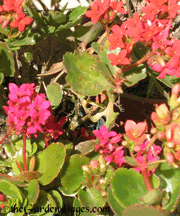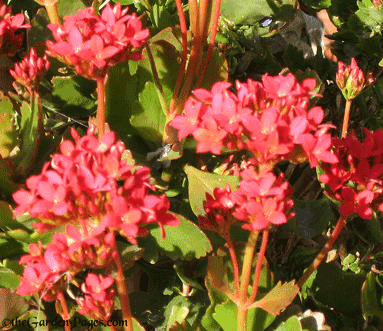You may not think of kalanchoes as succulent plants, but they are. Kalanchoes are another member of the Crassulaceae or Stonecrop family. They are reliable dry garden bloomers known for their bright flowers. Most varieties are perennial and evergreen, making them perfect candidates for my hot, dry landscape.
Their flowers bloom in small bouquets of upright clusters from 2 to 3 inches across, which are made up of small daisy-like flowers of 5 petals. Flower colors come in an amazing range; from white, yellow, orange, red, pink and everything in between. Flowers can also be creamy pastels or have flowers with more than one color on the petals.
One of the more popular varieties are kalanchoe blossfeldiana. A grouping of these drought tolerant plants make a bold statement in the garden. Bloom is heaviest in spring, but they can bloom all year with a little feeding of fertilizer after the first bloom.
Kalanchoe blossfeldiana have large, leathery leaves about 2 1/2 inches long and 1 1/2 inches wide. The leaf edges are usually lightly scalloped and may have a slight tint of red. They grow up to 2 feet tall and as wide. Some hybrid plants can have smooth edged leaves or different colors combinations.

Like most succulent plants, water requirements for kalanchoe are low. They can take average garden water, but will also grow well with much less. Mine are seldom watered and do fine on my average 7 inches of rainfall a year.
Kalanchoe plants are great in containers.You can pair them with other flowers or use them to fill in blank spots in the garden.They make nice patio table centerpieces too.Since they can handle drought, they are a bit more forgiving than other plants if you forget to water them!
Care of kalanchoe plants outdoors is easy in my mild-winter garden.They are hardy to USDA Zone 10b, or 35 degrees, (Sunset Zone: 17, 21-24),Outdoors, their sun requirements are from full sun to part shade.If it gets over 100 degrees for more than a few days your plants may develop brown spots which is a sign of sunburn.Either move the pots, or give them a little shade during the hottest part of the day with a temporary screen. Indoors they prefer a bright windowsill with lots of light.
Kalanchoes are popular gifts during the winter months and also make nice housewarming presents.If you are lucky enough to receive one, the first thing you might want to do is check if the soil is dry.If so, give your plant some water and let it drain in the sink for about an hour.
Seeds saved from any hybrid kalanchoe plants will not grow out to look the same as the parent plants. It is much easier to propagate your kalanchoe with leaf or stem cuttings. Take a small cutting about 2 or 3 inches long. Bury about half of the stem in damp soil and keep it slightly moist for the first two weeks. After that, let the soil dry out between waterings. This is a great, free way to expand your plant collection, or use them as gifts for your friends. Good luck and happy gardening!

So glad you dropped in on my page, because now I have found yours! Lovely blog and I shall enjoy following from now on.